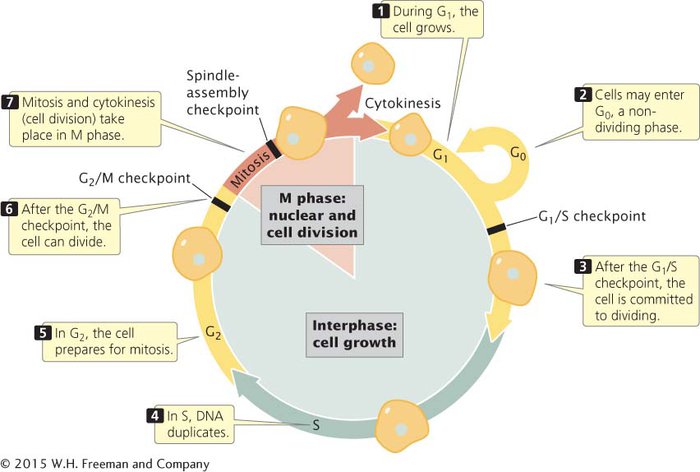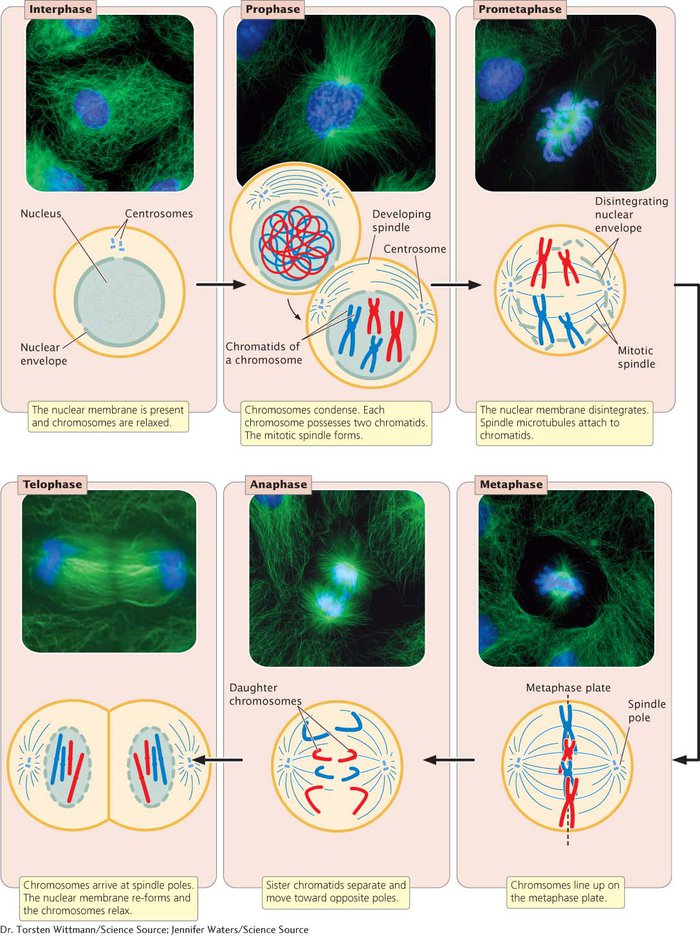The Cell Cycle and Mitosis
The cell cycle is the life story of a cell: the stages through which it passes from one division to the next (Figure 2.8). This process is critical to genetics because it is through the cell cycle that the genetic instructions for all characteristics are passed from parent cell to daughter cells. A new cell cycle begins after a cell has divided and produced two new cells. Each new cell metabolizes, grows, and develops. At the end of its cycle, it, too, divides to produce two cells, which can then undergo additional cell cycles. Progression through the cell cycle is regulated at key transition points called checkpoints, which allow or prohibit the cell’s progression to the next stage. Checkpoints ensure that all cellular components are present and in good working order, and they are necessary to prevent cells with damaged or missing chromosomes from proliferating. Defects in checkpoints can lead to unregulated cell growth, as is seen in some cancers. The molecular basis of these checkpoints will be discussed in Chapter 16.

The cell cycle consists of two major phases. The first is interphase, the period between cell divisions, in which the cell grows, develops, and functions. During interphase, critical events necessary for cell division also take place. The second is the M phase (mitotic phase), the period of active cell division. The M phase includes mitosis, the process of nuclear division, and cytokinesis, or cytoplasmic division. Let’s take a closer look at the details of interphase and the M phase.
INTERPHASE Interphase is the extended period of growth and development between cell divisions. Interphase includes several checkpoints.
By convention, interphase is divided into three phases: G1, S, and G2 (see Figure 2.8). Interphase begins with a phase called G1 (for gap 1). In G1, the cell grows and proteins necessary for cell division are synthesized; this phase typically lasts several hours. There is a critical point termed the G1/S checkpoint near the end of G1. The G1/S checkpoint holds the cell in G1 until the cell has all the enzymes necessary for the replication of DNA. After this checkpoint has been passed, the cell is committed to divide.
Before reaching the G1/S checkpoint, cells may exit the active cell cycle in response to regulatory signals and pass into a nondividing phase called G0, a stable state during which cells usually maintain a constant size. Cells can remain in G0 for an extended period, even indefinitely, or they can reenter G1 and the active cell cycle. Many cells never enter G0; rather, they cycle continuously.
After G1, the cell enters the S phase (for DNA synthesis), in which each chromosome is duplicated. Although the cell is committed to divide after the G1/S checkpoint has been passed, DNA synthesis must take place before the cell can proceed to mitosis. If DNA synthesis is blocked (by drugs or by a mutation), the chromosomes will not be duplicated, and the cell will not be able to undergo mitosis. Before the S phase, each chromosome is unreplicated; after the S phase, each chromosome is composed of two chromatids (see Figure 2.6).
After the S phase, the cell enters G2 (gap 2). In this phase, several additional biochemical events necessary for cell division take place. The G2/M checkpoint is reached near the end of G2. This checkpoint is passed only if the cell’s DNA is completely replicated and undamaged. Unreplicated or damaged DNA can inhibit the activation of some proteins that are necessary for mitosis to take place. After the G2/M checkpoint has been passed, the cell is ready to divide, and it enters the M phase. Although the length of interphase varies from cell type to cell type, a typical dividing mammalian cell spends about 10 hours in G1, 9 hours in S, and 4 hours in G2 (see Figure 2.8).
Throughout interphase, the chromosomes are in a relaxed, but by no means uncoiled, state, and individual chromosomes cannot be seen with a microscope. This condition changes dramatically when interphase draws to a close and the cell enters the M phase.
M PHASE The M phase is the part of the cell cycle in which the copies of the cell’s chromosomes (sister chromatids) separate and the cell undergoes division. The separation of sister chromatids in the M phase is a critical process that results in a complete set of genetic information for each of the daughter cells. Biologists usually divide the M phase into six stages: the five stages of mitosis (prophase, prometaphase, metaphase, anaphase, and telophase) illustrated in Figure 2.9, and cytokinesis. It’s important to keep in mind that the M phase is a continuous process and that its separation into these six stages is somewhat arbitrary.

Prophase As a cell enters prophase, the chromosomes become visible under a light microscope. Each chromosome possesses two chromatids because the chromosome was duplicated in the preceding S phase. The mitotic spindle, an organized array of microtubules that move the chromosomes in mitosis, forms. In animal cells, the spindle grows out from a pair of centrosomes that migrate to opposite sides of the cell. Within each centrosome is a special organelle, the centriole, which is also composed of microtubules. Some plant cells do not have centrosomes or centrioles, but they do have mitotic spindles.
Prometaphase Disintegration of the nuclear membrane marks the start of prometaphase. Spindle microtubules, which until now have been outside the nucleus, enter the nuclear region. When the end of a microtubule encounters a kinetochore, the microtubule becomes stabilized. Eventually, each chromosome becomes attached to microtubules from opposite poles of the spindle: for each chromosome, a microtubule from one of the centrosomes anchors to the kinetochore of one of the sister chromatids, and a microtubule from the opposite centrosome then attaches to the other sister chromatid, anchoring the chromosome to both of the centrosomes. This arrangement is known as chromosome bi-
orientation. Metaphase During metaphase, the chromosomes become arranged on a single plane, called the metaphase plate, between the two centrosomes. The centrosomes, now at opposite ends of the cell, with their microtubules radiating outward and meeting in the middle of the cell, are centered at the spindle poles. A spindle-
assembly checkpoint ensures that each chromosome is aligned on the metaphase plate and attached to spindle microtubules from opposite poles.Anaphase After the spindle-
assembly checkpoint is passed, the connection between sister chromatids breaks down, and the sister chromatids separate. This marks the beginning of anaphase, during which the chromosomes move toward opposite spindle poles. Telophase After the sister chromatids have separated, each is considered a separate chromosome. Telophase is marked by the arrival of the chromosomes at the spindle poles. The nuclear membrane re-
forms around each set of chromosomes, producing two separate nuclei within the cell. The chromosomes relax and lengthen, once again disappearing from view. In many cells, division of the cytoplasm (cytokinesis) is simultaneous with telophase.
The major features of the cell cycle are summarized in Table 2.1. You can watch the cell cycle in motion by viewing Animation 2.1. This interactive animation allows you to determine what happens when different processes in the cycle fail.  TRY PROBLEM 20
TRY PROBLEM 20
| Stage | Major features |
|---|---|
| G0 phase | Stable, nondividing period of variable length. |
| Interphase | |
| G1 phase | Growth and development of the cell; G1/S checkpoint. |
| S phase | Synthesis of DNA. |
| G2 phase | Preparation for division; G2/M checkpoint. |
| M phase | |
| Prophase | Chromosomes condense and mitotic spindle forms. |
| Prometaphase | Nuclear envelope disintegrates, and spindle microtubules anchor to kinetochores. |
| Metaphase | Chromosomes align on the metaphase plate; spindle- |
| Anaphase | Sister chromatids separate, becoming individual chromosomes that migrate toward spindle poles. |
| Telophase | Chromosomes arrive at spindle poles, the nuclear envelope re- |
| Cytokinesis | Cytoplasm divides; cell wall forms in plant cells. |